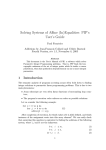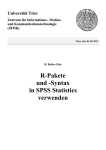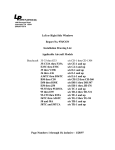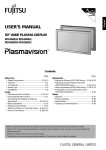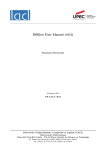Download WP 0.4 (Draft Manual) - Frama-C
Transcript
WP 0.4 (Draft Manual)
WP Plug-in (Draft) Manual
Version 0.4 for Nitrogen-20111001
Loïc Correnson, Zaynah Dargaye, Anne Pacalet
CEA LIST, Software Safety Laboratory
c
2010-2011
CEA LIST
This work has been supported by the ’U3CAT’ ANR project.
Contents
1 Introduction
7
1.1
Installation . . . . . . . . . . . . . . . . . . . . . . . . . . . . . . . . . . . . .
8
1.2
Tutorial . . . . . . . . . . . . . . . . . . . . . . . . . . . . . . . . . . . . . . .
8
1.3
Weakest Preconditions . . . . . . . . . . . . . . . . . . . . . . . . . . . . . . .
9
1.4
Memory Models . . . . . . . . . . . . . . . . . . . . . . . . . . . . . . . . . . .
11
2 Using WP Plug-in
13
2.1
Graphical User Interface . . . . . . . . . . . . . . . . . . . . . . . . . . . . . .
13
2.2
Command Line Options . . . . . . . . . . . . . . . . . . . . . . . . . . . . . .
15
2.2.1
Goal Selection
. . . . . . . . . . . . . . . . . . . . . . . . . . . . . . .
16
2.2.2
Program Entry Point . . . . . . . . . . . . . . . . . . . . . . . . . . . .
16
2.2.3
Model Selection . . . . . . . . . . . . . . . . . . . . . . . . . . . . . . .
17
2.2.4
Computation Strategy . . . . . . . . . . . . . . . . . . . . . . . . . . .
17
2.2.5
Decision Procedures Interface . . . . . . . . . . . . . . . . . . . . . . .
18
2.2.6
Generated Proof Obligations . . . . . . . . . . . . . . . . . . . . . . .
19
2.3
Plug-in Developer Interface . . . . . . . . . . . . . . . . . . . . . . . . . . . .
21
2.4
Plug-in Persistent Data . . . . . . . . . . . . . . . . . . . . . . . . . . . . . .
21
3 WP Models
23
3.1
Language of Proof Obligations
. . . . . . . . . . . . . . . . . . . . . . . . . .
23
3.2
The Hoare Memory Model . . . . . . . . . . . . . . . . . . . . . . . . . . . . .
24
3.3
Memory Models with Pointers . . . . . . . . . . . . . . . . . . . . . . . . . . .
24
3.4
Hoare Variables mixed with Pointers . . . . . . . . . . . . . . . . . . . . . . .
25
3.5
Hoare Variables for Reference Parameters . . . . . . . . . . . . . . . . . . . .
26
5
Chapter 1
Introduction
This document describes a Frama-C plug-in that uses external decision procedures to prove
ACSL annotations of C functions.
The WP plug-in is named after Weakest Precondition calculus, a technique used to prove program properties initiated by Hoare [Hoa69], Floyd [Flo67] and Dijkstra [Dij68]. Recent tools
implement this technique with great performances, for instance Boogie [Lei08] and Why [Fil03].
There is already a Frama-C plug-in, Jessie [MM09], developed at INRIA, that implements a
weakest precondition calculus for C programs by compiling them into the Why language.
The WP plug-in is a novel implementation of such a Weakest Precondition calculus for annotated C programs, which focuses on parametrization w.r.t the memory model. It is a
complementary work to Jessie plug-in, which relies on a separation memory model in the
spirit of Burstall’s work [Bur72]. The Jessie memory model is very efficient for a large variety
of well structured C-programs. However, it does not apply when low-level memory manipulations, such as heterogeneous casts, are involved. Moreover, Jessie operates by compiling
the C program to Why, a solution that prevents the user from combining weakest precondition
calculus with other techniques, such as the Value analysis plug-in.
The WP plug-in has been designed with cooperation in mind. That is, you may use WP for
proving some annotations of your C programs, and prove other ones with other plug-ins. The
recent improvements of the Frama-C kernel are then responsible for managing such partial
proofs and consolidate them altogether.
This manual is divided into three parts. This first chapter introduces the WP plug-in, the
Weakest Precondition calculus and Memory Models. Then, Chapter 2 details how to use and
tune the plug-in within the Frama-C platform. Finaly, Chapter 3 provides a description for
the included memory models.
7
CHAPTER 1. INTRODUCTION
1.1
Installation
The WP plug-in is distributed with the Frama-C platform. However, you must install at
least an external prover in order to fulfill proof obligations. You have several choices, see
section 2.2.5 for details. To begin with, you may install the Alt-Ergo [CCK06] prover. You
can install it from source at http://alt-ergo.lri.fr or with Godi.
1.2
Tutorial
Consider the very simple example of a function that swaps the values of two integers passed
by reference:
File swap.c
v o i d swap ( i n t *a , i n t *b)
{
i n t tmp = * a ;
* a = *b ;
*b = tmp ;
return ;
}
A simple, although incomplete, ACSL contract for this function can be:
File swap1.c
/∗@ ensures A: ∗a == \ o l d (∗b) ;
@ ensures B: ∗b == \ o l d (∗a ) ;
@∗/
v o i d swap ( i n t *a , i n t *b) ;
You can run wp on this example with:
# frama - c - wp swap . c swap1 . c
[ kernel ] preprocessing with " gcc -C -E -I . swap . c "
[ kernel ] preprocessing with " gcc -C -E -I . swap1 . c "
[ wp ] warning : Missing RTE guards
[ wp ] [ Alt - Ergo ] Goal s t o r e _ s w a p _ p o s t _ 2 _ B : Valid
[ wp ] [ Alt - Ergo ] Goal s t o r e _ s w a p _ p o s t _ 1 _ A : Valid
As expected, Alt-Ergo discharged the two proof obligations generated by WP for the swap
contract. You should notice the warning “Missing RTE guards”, emitted by the WP plug-in.
That is, the weakest precondition calculus implemented in WP relies on the hypothesis that
your program is runtime-error free. In this example, the swap function dereferences its two
parameters, and these two pointers should be valid.
The WP plug-in does not generate proof obligation to prevent your program from raising a
runtime error, because this property may be validated with any other technique, for instance
by running the value analysis plug-in or the rte generation one.
Hence, consider the following new contract for swap:
File swap2.c
/∗@ requires \ v a l i d ( a ) && \ v a l i d (b ) ;
@ ensures A: ∗a == \ o l d (∗b) ;
@ ensures B: ∗b == \ o l d (∗a ) ;
@ assigns ∗a , ∗b ;
@∗/
v o i d swap ( i n t *a , i n t *b) ;
For simplicity, the WP plug-in is able to run the rte generation plug-in for you. Now, WP
reports that the function swap fulfills its contract:
8
1.3. WEAKEST PRECONDITIONS
# frama - c - wp -wp - rte swap . c swap2 . c
[ kernel ] preprocessing with " gcc -C -E -I . swap . c "
[ kernel ] preprocessing with " gcc -C -E -I . swap2 . c "
[ rte ] annotating function swap
[ wp ] [ WP : simplified ] Goal s t o r e _ s w a p _ f u n c t i o n _ a s s i g n s : Valid
[ wp ] [ Alt - Ergo ] Goal s t o r e _ s w a p _ a s s e r t _ 4 _ r t e : Valid
[ wp ] [ Alt - Ergo ] Goal s t o r e _ s w a p _ a s s e r t _ 3 _ r t e : Valid
[ wp ] [ Alt - Ergo ] Goal s t o r e _ s w a p _ a s s e r t _ 2 _ r t e : Valid
[ wp ] [ Alt - Ergo ] Goal s t o r e _ s w a p _ a s s e r t _ 1 _ r t e : Valid
[ wp ] [ Alt - Ergo ] Goal s t o r e _ s w a p _ p o s t _ 2 _ B : Valid
[ wp ] [ Alt - Ergo ] Goal s t o r e _ s w a p _ p o s t _ 1 _ A : Valid
We have finished the job of validating this simple C program with respect to its specification,
as reported by the report plug-in that displays a consolidation status of all annotations:
# frama - c -wp - verbose 0 [...] - then - report
[ kernel ] preprocessing with " gcc -C -E -I . swap . c "
[ kernel ] preprocessing with " gcc -C -E -I . swap2 . c "
[ rte ] annotating function swap
[ report ] Computing properties s t a t u s ...
---------------------------------------------------------------------------------- Properties of Function ’ swap ’
-------------------------------------------------------------------------------[
Valid
[
Valid
[
Valid
[
Valid
[
Valid
[
Valid
[
Valid
[
Valid
] Post - condition ’A ’
by WP - Store .
] Post - condition ’B ’
by WP - Store .
] Assigns ( file swap2 .c , line 4)
by WP - Store .
] Assertion ’rte ’ ( generated )
by WP - Store .
] Assertion ’rte ’ ( generated )
by WP - Store .
] Assertion ’rte ’ ( generated )
by WP - Store .
] Assertion ’rte ’ ( generated )
by WP - Store .
] Default behavior
by Frama - C kernel .
---------------------------------------------------------------------------------- Status Report Summary
-------------------------------------------------------------------------------8 Completely validated
8 Total
--------------------------------------------------------------------------------
1.3
Weakest Preconditions
The principles of weakest precondition calculus are quite simple in essence. Given a code annotation of your program, say, an assertion Q after a statement stmt, the weakest precondition
of P is by definition the “simplest” property P that must be valid before stmt such that Q
holds after the execution of stmt.
Hoare’s triples. In mathematical terms, we denote such a property by a Hoare’s triple:
{P } stmt {Q}
which reads: “whenever P holds, then after running stmt, Q holds”.
9
CHAPTER 1. INTRODUCTION
Thus, we can define the weakest precondition as a function wp over statements and properties
such that the following Hoare triple always holds:
{wp(stmt, Q)} stmt
{Q}
For instance, consider a simple assignment over an integer local variable x; we have:
{x + 1 > 0} x = x + 1; {x > 0}
It should be intuitive that in this simple case, the weakest precondition for this assignment of
a property Q over x can be obtained by replacing x with x + 1 in Q. More generally, for any
statement and any property, it is possible to define such a weakest precondition.
Verification. Consider now function contracts. We basically have pre-conditions, assertions
and post-conditions. Say function f has a precondition P and a post condition Q, we now
want to prove that f satisfies its contract, which can be formalized by:
{P } f
{Q}
Consider now W = wp(f, Q), we have by definition of wp:
{W } f
{Q}
Suppose now that we can prove that P entails W : we can use the intermediate result of
the weakest precondition calculus to prove the function contracts. This operation can be
summarized by the following diagram:
(P =⇒ W )
{W } f {Q}
{P } f {Q}
This is the main idea of how to prove a property by weakest precondition computation.
Consider an annotation Q, compute its weakest precondition W across all the statements
from Q up to the beginning of the function. Then, submit the property P =⇒ W to a
theorem prover, where P are the preconditions of the function. If this proof obligation is
discharged, then one may conclude the annotation Q is valid for all executions.
Termination. We must point out a detail about program termination. Strictly speaking,
the weakest precondition of property Q through statement stmt should also ensure termination
and execution without runtime error.
The proof obligations generated by WP do not entail systematic termination, unless you systematically specify and validate loop variant ACSL annotations. Nevertheless, exit behaviors
of a function are correctly handled by WP.
Regarding runtime errors, the proof obligations generated by WP assume your program never
raises any of them. Moreover, the only integer model currently implemented assumes no
integer overflow at all (signed or unsigned). As illustrated in the short tutorial example of
section 1.2, you should enforce the absence of runtime error on your own, for instance by
running the value analysis plug-in or the rte generation one.
10
1.4. MEMORY MODELS
Provers. The WP plug-in computes proof obligations for post-conditions and assertions in
C functions, and submits them to external provers.
You may discharge the generated proof obligation with automated decision procedures or an
interactive proof assistant. Technically, WP is interfaced with Alt-Ergo [CCK06], Coq [Coq10],
and any decision procedure supported by Why [Fil03].
1.4
Memory Models
The essence of a weakest precondition calculus is to translate code annotation into mathematical properties. Consider the simple case of an annotation referring to a non-pointer C-variable
x:
x = x +1;
//@ a s s e r t P: x >= 0 ;
We can translate P into the mathematical property P (X) = X ≥ 0, where X stands for
the value of variable x at the appropriate program point. In this simple case, the effect of
statement x=x+1 over P is actually the substitution X 7→ X + 1, that is X + 1 ≥ 0.
The problem when applying weakest precondition calculus to C programs is to deal with
pointers. Consider now:
p = &x ;
x = x +1;
//@ a s s e r t Q: ∗p >= 0 ;
It is clear that, taking into account the aliasing between *p and x, the effect of the increment
of x can not be translated by a simple substitution of X in Q.
This is where memory models comes to rescue.
A memory model defines a mapping from values inside the C memory heap to mathematical
terms. The WP has been designed to support different memory models. There are currently
three memory models implemented, and we plan to implement new ones in future releases.
Those three models are all different from the one in the Jessie plug-in, which makes WP
complementary to Jessie.
Hoare model. A very efficient model that generates concise proof obligations. It simply maps
each C variable to one pure logical variable.
However, the heap can not be represented in this model, and expressions such as *p can
not be translated at all. You can still represent pointer values, but you can not read or
write the heap through pointers.
Store model. The default model for WP plug-in. Heap values are stored in a global array.
Pointer values are translated into an index into this array.
In order to generate reasonable proof obligations, the values stored in the global array are
not the machine-ones, but the logical ones. Hence, all C integer types are represented by
mathematical integers and each pointer type to a given type is represented by a specific
logical abstract datatype.
A consequence is that heterogeneous cast of pointers can not be translated in this model.
For instance within this memory model, you can not cast a pointer to int into a pointer
to char, and then access the internal representation of an int value in memory.
11
CHAPTER 1. INTRODUCTION
Runtime model. This is a low-level memory model, where the heap is represented as a wide
array of bits. Pointer values are exactly translated into memory addresses. Read and
write operations from/to the heap are translated into manipulation of range of bits in
the heap.
This model is very precise in the sense that all the details of the program are represented.
This comes at the cost of huge proof obligations that are very difficult to discharge by
automated provers, and generally require an interactive proof assistant.
Thus, each memory model offers a different trade-off between expressive power and ease of
discharging proof obligations. The Hoare memory model is very restricted but generates easy
proof obligations, Runtime is very expressive but generates difficult proof obligations, and
Store offers an intermediate solution.
12
Chapter 2
Using WP Plug-in
The WP plug-in can be used from the Frama-C command line or within its graphical user
interface. It is a dynamically loaded plug-in, distributed with the kernel since the Carbon
release of Frama-C.
This plug-in computes proof obligations of programs annotated with ACSL annotations by
weakest precondition calculus, using a parametrized memory model to represent pointers and
heap values. The proof obligations may then be discharged by external decision procedures,
which range over automated theorem provers such as Alt-Ergo [CCK06] or interactive proof
assistant like Coq [Coq10].
This chapter describes how to use the plug-in, from the Frama-C graphical user interface
(section 2.1), from the command line (section 2.2), or from another plug-in (section 2.3).
Additionally, the combination of the WP plug-in with the load and save commands of FramaC and/or the -then command-line option is explained in section 2.4.
2.1
Graphical User Interface
To use WP under the GUI, you simply need to run the Frama-C graphical user interface. No
additional option is required, although you can preselect some of the WP options described
in section 2.2:
$ frama -c - gui [ options ...] *. c
As we can see in figure 2.1, the memory model, the decision procedure, and some WP options
can be tuned from the WP side panel. Others options of the WP are still modifiable from the
Properties button in the main GUI toolbar.
To prove a property, just select it in the internal source view and chose WP from the contextual
menu. The Console window outputs some information about the computation. Figure 2.2
displays an example of such a session.
If everything succeeds, a green bullet should appear on the left of the property. The computation can also be run for a bundle of properties if the contextual menu is open from a function
or behavior selection.
The options from the WP side panel correspond to some options of the plug-in command-line.
Please refer to section 2.2 for more details. In the graphical user interface, there are also
specific panels that display more details related to WP, that we shortly describe below.
13
CHAPTER 2. USING WP PLUG-IN
Figure 2.1: WP in the Frama-C GUI
Figure 2.2: WP run from the GUI
14
2.2. COMMAND LINE OPTIONS
Source Panel. On the center of the Frama-C window, the status of each code annotation is
reported in the left-margin. The meaning of icons is the same for all plug-ins in Frama-C and
more precisely described in the general user’s manual of the platform. The status emitted by
the WP plug-in are:
Icons for properties:
No proof attempted.
The property has not been validated.
The property is valid but has dependencies.
The property and all its dependencies are valid.
Proof Obligations Panel. This panel is dedicated to the WP plug-in. It shows the generated proof obligations and their status for each prover. By clicking on a prover column, you
can also submit a proof obligation to a prover by hand. By double-clicking an annotation,
you can view its mathematical definition in a human readable format.
Properties Panel. This panel summarizes the consolidated status of properties, from various plug-ins. This panel is not automatically refreshed. You should press the Refresh button
to update it. This panel is described in more details in the general Frama-C platform user’s
manual.
Property Dependency Graph. By double-clicking on the status column of a property
in the properties panel, you can display a dependency graph for this property. The graph
displays the property, its status, which plug-in has participated in the proof, and on which
properties the proof directly depends on.
2.2
Command Line Options
The best way to know which options are available is to use:
# frama - c -wp - help
The WP plug-in generally operates in three steps:
1. Annotations are selected to produce a control-flow graph of elementary statements annotated with hypothesis and goals.
2. Weakest preconditions are computed for all selected goals in the control-flow graph.
Proof obligations are emitted and saved on disk.
3. Decision procedures (provers) are run to discharge proof obligations.
The WP options allow to refine each step of this process. It is very convenient to use WP
together with the standard -then option of Frama-C, in order to operate successive pass on
the project. See section 2.4 for details.
15
CHAPTER 2. USING WP PLUG-IN
2.2.1
Goal Selection
This group of options refines the selection of annotations for which proof obligations are
generated. By default, all annotations are selected. By default, a property which is already
proved – by WP or any other plug-in – does not lead to any proof-obligation generation.
-wp generates proof obligations for all (selected) properties.
-wp-fct <f1,...,fn> selects annotations of functions f1,...,fn (defaults to all functions).
-wp-bhv <b1,...,bn> selects annotation for behaviors b1,...bn (defaults to all behaviors).
-wp-prop <p> selects properties with name p (defaults to all properties). You may also type
“assigns” for all assigns properties.
-wp-(no)-status-all includes in the goal selection all properties regardless of their current
status (default is: no).
-wp-(no)-status-valid includes in the goal selection those properties for which the current
status is already ’valid’ (default is: no).
-wp-(no)-status-invalid includes in the goal selection those properties for which the current status is already ’invalid’ (default is: no).
-wp-(no)-status-maybe includes in the goal selection those properties with an undetermined
status (default is: yes).
Remark: options -wp-status-xxx are not taken into account when selecting a property by
its name or from the Gui.
2.2.2
Program Entry Point
The generic Frama-C options dealing with program entry point are taken into account by WP
as follows:
-main <f> designates f to be the main entry point (defaults to main).
-lib-entry the main entry point (as defined by option -main) is analyzed regardless of its
initial context (default is no).
These options impact the generation of proof-obligations for the “requires” contract of the
main entry point. More precisely, if there is a main entry point, and -lib-entry is not set:
• the global variables are set to their initial values at the beginning of the main entry
point for all its properties to be established ;
• special proof obligations are generated for the preconditions of the main entry point,
hence to be proved with globals properly initialized.
Otherwise, initial values for globals are not taken into account and no proof obligation is
generated for preconditions of the main entry point.
16
2.2. COMMAND LINE OPTIONS
2.2.3
Model Selection
These options modify the underlying memory model that is used for computing weakest
preconditions. See chapter 3 for details.
-wp-model <m> sets the memory model among Hoare, Store or Runtime. For more information about the models and how to choose it, see section 1.4.
-wp-(no)-logicvar (deactivates) optimization for variables whose address is never taken, for
which WP uses the Hoare model (default is: yes).
-wp-(no)-byreference (deactivates) detection of arguments passed by reference (as pointers), for which WP may also use the Hoare model under some hypotheses (default is:
no).
-wp-assigns <m> sets the method for proving assigns clauses. Possible methods are:
effect: Each statement with side-effect produces one sub-goal. The locations written
by each statement are checked to be included in the assigns clause. This is a
stronger result than required, but the proof obligations are generally simple and
sufficient in practice.
memory: use the ACSL definition of assigns clauses, where memory states are compared before and after the considered block. Generates much more complex proof
obligations than effect.
none: skip proof of assigns clauses.
2.2.4
Computation Strategy
These options modifies the way proof obligations are generated during weakest precondition
calculus.
-wp-invariants computes proof obligations for arbitrary invariants inside loops. Also modifies the calculus for proper loop invariants. This option automatically turns splitting
on (see -wp-split)1 .
-wp-huge <s> cuts off proof terms with size exceeding 2s (default: 230 ). The size of a term is
linearly related to its size on the disk, and to the size of proof obligation sent to decision
procedures.
-wp-norm <m> sets the normalization method applied to let-bindings in obligations generated
for Alt-Ergo and Coq:
Eqs: let-bindings are replaced by universally-quantified fresh variables with the associated defining equalities in hypothesis (default).
Let: let-bindings are preserved.
Exp: let-bindings are expanded.
1
To be efficient, it is better to put all the loop invariants inside only one annotation. Otherwise, Frama-C
insert them at different program points. Then, the WP cut the generated proof obligations at each invariant
instead of proving all of them inside the same induction scheeme.
Notice that, when using the ACSL-Importer plug-in, all the loop invariants are placed at one unique program
point, and are treated efficiently by WP.
17
CHAPTER 2. USING WP PLUG-IN
Cc: let-bindings are replaced by function call or predicates by closure conversion.
-wp-rte generates RTE guards before computing weakest preconditions. This option calls the
rte generation plug-in with the following options: -rte-mem, -rte-div, -rte-signed
and -rte-unsigned-ov. The generated guards, when proved2 , fulfill the requirements
for using the WP plug-in.
-wp-(no)-simpl (deactivates) simplification of constant expressions and tautologies.
-wp-split conjunctions in generated proof obligations are recursively split into sub-goals.
The generated goal names are suffixed by “partn”. Notice that this option is set by
default for assigns clauses when using the effect assigns method (see -wp-assigns
above).
-wp-split-dim <d> limits the number of generated sub-goals for assigns goals when using
-wp-split. The number of generated sub-goals will not exceed 2d proof obligations.
Default is 26 .
2.2.5
Decision Procedures Interface
When the -wp-proof option is selected, proof obligations are sent to a decision procedure.
If proof obligations have just been generated, by using -wp, -wp-fct, -wp-bhv or -wp-prop,
then only the new proof obligations are sent. Otherwise, all unproved proof obligations are
sent.
-wp-check <dp> only checks the syntax of generated proof obligations for a family of decision
procedures. Possible values of dp are: alt-ergo, coq and why.
-wp-par <n> limits the number of parallel process runs for decision procedures. Defaults is
4 processes. With -wp-par 1, the order of logged results is fixed. With more processes,
the order is runtime dependent.
-wp-proof <dp> selects the decision procedure used to discharge proof obligations. See below
for supported provers. By default, alt-ergo is selected, but you may specify another
decision procedure, or none to skip the proof step.
-wp-proof-trace asks for provers to output extra information when available.
-wp-timeout <n> sets the timeout (in seconds) for the calls to the decision prover (defaults
to 10 seconds).
-wp-trace keeps user labels in generated proof obligations. This option can be useful for
tracing where the proof obligations come from, especially when using -wp-split option
or interactive proof assistants.
Alt-Ergo Direct support for the Alt-Ergo prover is provided. You need at least version 0.93
of the prover. You select it with -wp-proof alt-ergo option. It is also the default selected
prover.
2
It is still correct to prove these RTE annotations with WP
18
2.2. COMMAND LINE OPTIONS
Coq. Direct support for the Coq proof assistant is provided. The generated proof obligations
are accepted by Coq version 8.3 but should also work with prior versions of the proof assistant.
When working with Coq, you will enter interactive session, then save the proof scripts in order
to replay them in batch mode.
-wp-script <f.script> specifies the file which proof scripts are retrieved from, or saved to.
The format of this file is private to the WP plug-in. It is, however, a regular text file
from which you can cut and paste part of previously written script proofs. The WP
plug-in manages the content of this file for you.
-wp-proof coq only runs coqc on proof scripts found in the script file. If the generated
goal (or the default one) is not correctly typed-checked by coqc, the coq prover fails to
discharge the proof obligation.
-wp-proof coqide first tries to replay some known proof script (if any). If it does not
succeed, then a new interactive session for coqide is opened. During this session,
several files are opened for you:
<goal>.v the proof obligation to discharge.
<model>_env<n>.v the environment generated during weakest precondition calculus
(already compiled by coqc): type definitions, global variables, etc.
<model>_model.v the definitions and properties of the memory model used (already
compiled by coqc).
f.script the script file where all your proofs are stored. This is useful for reusing parts
from previous scripts on similar goals.
As soon as coqide exits, the edited proof script is saved back to the script file, and
finally checked by coqc. Do not forget to save your proof before exiting coqide.
Why. Finally, a wide range of automated provers are supported by WP thanks to the
Why 2.29 prover interface. Both the why translation tool and the why-dp utility are required.
You also need to install external provers by your own. Currently, the provers you can use
with WP and Why, and the corresponding values for the -wp-proof option, are: simplify,
yices, cvc3, vampire, z3, zenon.
2.2.6
Generated Proof Obligations
Your proof obligations are generated and saved to several text files. With the -wp-out option,
you can specify a directory of your own where all these files are generated. By default, this
output directory is determined as follows: under the GUI, it is <home>/.frama-c-wp where
<home> is the user’s home directory returned by the HOME environment variable. In commandline, a temporary directory is automatically created and removed at Frama-C exit.
The other options controlling the output of generated proof obligations are:
-wp-print pretty-prints the generated proof obligations on the standard output. Results
obtained by provers are reported as well.
-wp-warnings displays details when warnings are emitted during proof obligation generation.
-wp-out <dir> sets the user directory where proof obligations are saved. The directory is
created if it does not exist yet. Its content is not cleaned up automatically.
19
CHAPTER 2. USING WP PLUG-IN
-wp-dot generates a graphical representation of the CFG in the dot format used by the
GraphViz tools3 .
The output directory contains a lot of files. All files are generated with the following naming
convention:
<goal>_head.txt a summary of the generated proof obligation. This file contains the warning
emitted during weakest precondition calculus.
<goal>_body.txt a human-readable description of the proof obligation.
<goal>_log_<prover>.txt a log from the prover when it has been run on the goal.
The complete goal submitted to external provers:
<goal>_po.why for WHY.
<goal>_po_why.<ext> generated by WHY for external decision procedures.
<goal>_po_ergo.why for Alt-Ergo without arrays.
<goal>_po_aergo.why for Alt-Ergo with arrays.
<goal>_po.v for Coq.
Each complete goal actually consists of the specification of the model, an environment describing the C definitions of your program, and the elementary goal itself. The environments
are:
<env>.txt in human-readable description of the environment.
<env>.why for Why.
<env>_ergo.why for Alt-Ergo without arrays.
<env>_aergo.why for Alt-Ergo with arrays.
<env>.v for Coq.
The elementary goals are:
<goal>.why the elementary goal generated for WHY.
<goal>_ergo.why the elementary goal generated for Alt-Ergo without arrays.
<goal>_aergo.why the elementary goal generated for Alt-Ergo with arrays.
<goal>.v the elementary goal generated for Coq.
3
http://www.graphviz.org
20
2.3. PLUG-IN DEVELOPER INTERFACE
Finally, definitions and properties of the memory model are distributed in the Frama-C
share/wp directory with similar naming conventions. Their Coq instances are copied on
the temporary directory for separate compilation purposes.
To discharge a proof obligation, WP assembles an input for the external decision prover
composed of three inputs: the resources for selected memory model, the resources from the
environment of the goal, and the goal itself.
Remark: to save space on disk, when generating proof obligations from the command line,
the proof obligations are only generated for the requested prover format. This behavior is
turned off under the Gui and in debug mode. Hence, you still get all formats available for all
provers in these cases.
2.3
Plug-in Developer Interface
The WP plug-in has several entry points registered in the Dynamic4 module of Frama-C:
Wp.run runs the weakest precondition calculus using the options to know what to compute.
This is similar to using -wp on the command line;
Wp.wp_compute kf_opt bhv_list_opt prop_opt where:
• kf_opt is an optional kernel function;
• bhv_list_opt specifies an optional behavior list;
• prop_opt specifies an optional property;
These entry points actually run the WP plug-in in the same way than the command-line
options do.
2.4
Plug-in Persistent Data
As a general observation, almost none of the internal WP data is kept in memory after each
execution. Most of the generated proof-obligation data is stored on disk before being sent to
provers, and they are stored in a temporary directory that is removed upon Frama-C exit (see
also -wp-out option).
The only information which is added to the Frama-C kernel consists in a new status for those
properties proved by WP with their dependencies.
Warning: the WP plug-in does not work – yet – with several Frama-C projects in the same
run. Thus, when combining WP with -then, -save and -load options, the user should be
aware of the following precisions:
-wp, -wp-prop, -wp-fct, -wp-bhv. These options make the WP plug-in generate proofobligations for the selected properties. The value of theses option are never saved and
they are cleared by -then. Hence, running -wp-prop A, then -wp-fct F does what you
expect.
4
See the plug-in development guide
21
CHAPTER 2. USING WP PLUG-IN
-wp-print, -wp-proof, -wp-check. These options do not generate new proof-obligations,
but run other actions on all previously generated ones. For the same reasons, they are
not saved and cleared by -then.
-wp-xxx. All other options are tunings that can be easily turned on and off or set to the
desired value. They are saved and kept across -then command.
22
Chapter 3
WP Models
Basically, a memory model is a set of datatypes, operations and properties that are used to
abstract the values living inside the heap during the program execution.
Each memory model defines its own representation of pointers, memory and data actually
stored in the memory. The memory models also define some types, functions and properties
required to translate C programs and ACSL annotations into first order logic formulæ.
The interest of developing several memory models is to manage the trade-off between the
precision of the heap’s values representation and the difficulty of discharging the generated
proof obligations by external decision procedures. If you chose a very accurate and detailed
memory model, you shall be able to generate proof obligations for any program and annotations, but most of them would be hardly discharged by state-of-the art external provers. On
the other hand, for most C programs, simplified models are applicable and will generate less
complex proof obligations that are easier to discharge.
A practical methodology is to use the simpler models whenever it is possible, and to up the
ante with more involved models on the remaining more complex parts of the code.
This chapter is dedicated to the description of the memory models implemented by the WP
plug-in. In this preliminary version of the manual, we only provide a high-level description
of the memory models you might select with option -wp-model (section 3.2 and 3.3). Then
we focus on two general powerful optimizations. The first one, activated by default and
controlled by option -wp-(no)-logicvar (section 3.4), mixes the selected memory model
with the purely logical Hoare model for those parts of your program that never manipulate
pointers. The second one, controled by option -wp-byreference (section 3.5), is dedicated
to those pointers that are formal parameters of function passed by reference.
3.1
Language of Proof Obligations
The work of WP consists in translating C and ACSL constructs into first order logical formulæ.
We denote by L the logic language for constructing proof obligations. Shortly, this logical
language is made of terms (t : term) and propositions (P : prop) made of:
• Natural, signed, unbounded integer constants and their operations;
• Natural real numbers and their operations;
• Arrays (as total maps) and tuples;
23
CHAPTER 3. WP MODELS
• Abstract (polymorphic) data types;
• Anonymous function symbols;
• Logical connectors;
• Universally and existentially quantified variables.
Actually, the task of the memory model consists in mapping any heap C-values at a given
program point to some variable or term in the logical L language.
3.2
The Hoare Memory Model
This is the simplest model, inspired by the historical definition of Weakest Precondition Calculus for programs with no pointers. In such programs, each global and local variable is
assigned a distinct variable in L.
Consider for instance the statement x++; where x has been declared as an int . In the Hoare
memory model, this C-variable will be assigned to two L-variables, say x1 before the statement,
and x2 after the statement, with the obvious relation x2 = x1 + 1 (if no overflow occurred).
Of course, this model is not capable of handling memory reads or writes through pointer
values, because there is no way of representing aliasing.
You select this memory model in the WP plug-in with the option -wp-model Hoare; the
analyzer will complain whenever you attempt to access memory through pointers with this
model.
3.3
Memory Models with Pointers
Realistic memory models must deal with reads and writes to memory through pointers. However, there are many ways for modeling the raw bit stream the heap consists of. All memory
models M actually implement a common signature:
Pointer Type: τ , generally a pair of a base address and an offset.
Heap Variables: for each program point, there is a set of logical variables to model the
heap. For instance, you may have a variable for the values at a given address, and
another one for the allocation table. The heap variables m1 . . . mk are denoted by m.
Read Operation: given the heap variables m, a pointer value p : τ , and some C-type T , the
model will define an operation:
readT (m, p) : term
that defines the representation in L of the value of C-type T which is stored at address
p in the heap.
Write Operation: given the heap variables m before a statement, and their associated heap
variables m0 after the statement, a pointer value p : τ and a value v of C-type T , the
model will define a relation:
writeT (m, p, v, m0 ) : prop
that relates the heap before and after writing value v at address p in the heap.
24
3.4. HOARE VARIABLES MIXED WITH POINTERS
Typically, consider the statement (*p)++ where p is a C-variable of type ( int *). The memory
model M will assign a unique pointer value P : τ to the address of p in memory.
Then, it retrieves the actual value of the pointer p, say Ap , by reading a value of type int *
into the memory variables m at address P :
Ap = readint∗ (m, P )
Next, the model retrieves the previous int -value at actual address Ap , say Vp :
Vp = readint (m, Ap )
Finally, the model relates the final memory state m0 with the incremented value Vp + 1 at
address P :
writeint (m, Ap , Vp + 1, m0 )
There are two such models with pointers available with the WP plug-in:
-wp-model Store : a simple memory model with two heap-variables. One is for the allocation
table that deals with pointer validity. The second one stores numerical and pointer
values into an array indexed by pointers. This model is not capable of handling unions
and casts of pointer types.
-wp-model Runtime : a low-level memory model, also with two heap-variables. One is for
the allocation table, and second one stores all values of the heap as an array of bytes
indexed by pointers. All operations can be handled by this model, but the generated
proof obligations are generally untractable by automated decision procedures.
3.4
Hoare Variables mixed with Pointers
As illustrated above, a very simple statement is generally translated by memory models into
complex formulæ. However, it is possible in some situations to mix the Hoare memory model
with the other ones.
For instance, assume the address of variable x is never taken in the program. Hence, it is not
possible to create a pointer aliased with &x. It is thus legal to manage the value of x with
the Hoare memory model, and other values with another memory-model M that deals with
pointers.
Common occurrences of such a situation are pointer variables. For instance, assume p is a
variable of type int *; it is often the case that the value of p is used (as in *p), but not the
address of the variable p itself, namely &p. Then, it is very efficient to manage the value of p
with the Hoare memory model, and the value of *p with a memory model with pointers.
Such an optimization is possible whenever the address of a variable is never taken in the
program. It is activated by default in the WP plug-in, since it is very effective in practice.
You can nevertheless deactivate it with option -wp-no-logicvar.
25
CHAPTER 3. WP MODELS
3.5
Hoare Variables for Reference Parameters
A common programming pattern in C programs is to use pointers for function arguments
passed by reference. For instance, consider the swap function below:
v o i d swap ( i n t *a , i n t *b)
{
i n t tmp = * a ;
* a = *b ;
*b = tmp ;
}
Since neither the address of a nor the one of b are taken, their values can be managed by the
Hoare Model as described in previous section. But we can do even better. Remark that none
of the pointer values contained in variables a and b is stored in memory. The only occurrences
of these pointer values are in expressions *a and *b. Thus, there can be no alias with these
pointer values elsewhere in memory, provided they are not aliased initially.
Hence, not only can a and b be managed by the Hoare model, but we can also treat (*a) and
(*b) expressions as two independent variables of type int with the Hoare memory model.
For the callers of the swap function, we can also take benefit from such by-reference passing
arguments. Typically, consider the following caller program:
void f ( void )
{
i n t x =1 , y =2 ;
swap (&x ,& y );
}
Strictly speaking, this program takes the addresses of x and y. Thus, it would be natural to
handle those variables by a model with pointers. However, swap will actually always use *&x
and *&y, which are respectively x and y.
In such a situation it is then correct to handle those variables with the Hoare model, and this
is a very effective optimization in practice. Notice however, that in the example above, the
optimization is only correct because x and y have disjoint addresses.
These optimizations can be activated in the WP plug-in with the -wp-byreference option, and the necessary separation conditions are generated on-the-fly. To summarize, the
-wp-byreference option:
• detects pointer or array variables that are always passed by reference.
• generates additional pre-conditions to prevent aliasing between arguments at call sites.
• assigns the detected variables passed by reference to the Hoare memory model.
This optimization is not activated by default, since the non-aliasing hypotheses at call sites
are sometimes irrelevant.
26
BIBLIOGRAPHY
Bibliography
[Bur72] R. M. Burstall. Some techniques for proving correctness of programs which alter
data structures. Machine Intelligence, 1972.
[CCK06] Sylvain Conchon, Evelyne Contejean, and Johannes Kanig. Ergo : a theorem prover
for polymorphic first-order logic modulo theories, 2006.
[Coq10] Coq Development Team. The Coq Proof Assistant Reference Manual – Version V8.3,
2010.
[Dij68] Edsger W. Dijkstra. A constructive approach to program correctness. BIT Numerical
Mathematics, Springer, 1968.
[Fil03]
J.-C. Filliâtre. Why: a multi-language multi-prover verification tool. Research Report
1366, LRI, Université Paris Sud, March 2003.
[Flo67] R. W. Floyd. Assigning meanings to programs. Proceedings of the American Mathematical Society Symposia on Applied Mathematics, 19, 1967.
[Hoa69] C. A. R. Hoare. An axiomatic basis for computer programming. Communications of
the ACM, 1969.
[Lei08] K. Rustan M. Leino. This is Boogie 2. Microsoft Research, 2008.
[MM09] Yannick Moy and Claude Marché. Jessie Plugin Tutorial, Beryllium version. INRIA,
2009. http://www.frama-c.cea.fr/jessie.html.
27




























